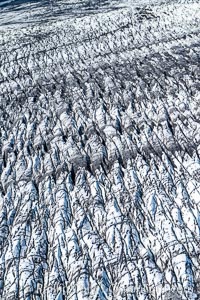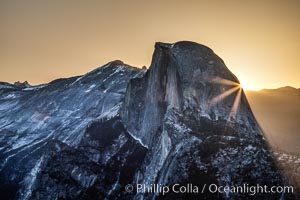
Half Dome at sunrise, viewed from Glacier Point.
Location: Yosemite National Park, California
Image ID: 27737
Location: Yosemite National Park, California
Image ID: 27737
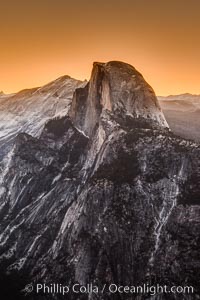
Half Dome and pre-dawn light, sunrise, viewed from Glacier Point.
Location: Yosemite National Park, California
Image ID: 27739
Location: Yosemite National Park, California
Image ID: 27739
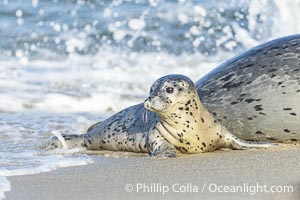
Pacific Harbor Seal Young Young Pup, only days old, exiting the ocean, beside its mother on the beach at the Children's Pool in La Jolla.
Species: Pacific harbor seal, Phoca vitulina richardsi
Location: La Jolla, California
Image ID: 39056
Species: Pacific harbor seal, Phoca vitulina richardsi
Location: La Jolla, California
Image ID: 39056
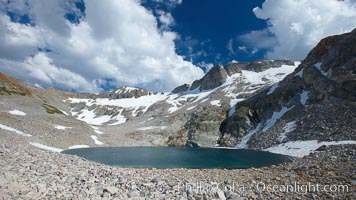
Nameless Lake (10709'), surrounded by glacier-sculpted granite peaks of the Cathedral Range, near Vogelsang High Sierra Camp.
Location: Yosemite National Park, California
Image ID: 23205
Location: Yosemite National Park, California
Image ID: 23205
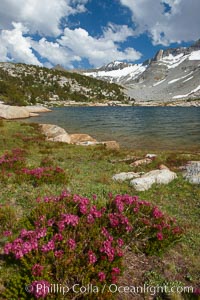
Townsley Lake (10396'), a beautiful alpine lake sitting below blue sky, clouds and Fletcher Peak (right), lies amid the Cathedral Range of glacier-sculpted granite peaks in Yosemite's high country, near Vogelsang High Sierra Camp.
Location: Yosemite National Park, California
Image ID: 23219
Location: Yosemite National Park, California
Image ID: 23219
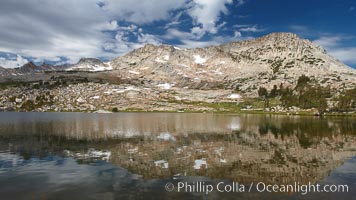
Vogelsang Peak reflected in spectacular Vogelsang Lake, in Yosemite's high country near the John Muir Trial and Vogelsang High Sierra Camp. Vogelsang Peak (11516') was sculpted by glaciers from monolithic granite.
Location: Yosemite National Park, California
Image ID: 23225
Location: Yosemite National Park, California
Image ID: 23225
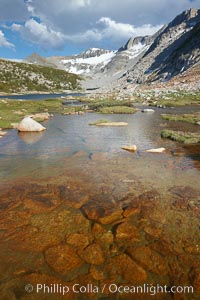
Townsley Lake (10396'), a beautiful alpine lake sitting below blue sky, clouds and Fletcher Peak (right), lies amid the Cathedral Range of glacier-sculpted granite peaks in Yosemite's high country, near Vogelsang High Sierra Camp.
Location: Yosemite National Park, California
Image ID: 23228
Location: Yosemite National Park, California
Image ID: 23228
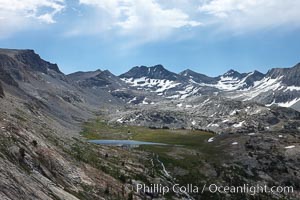
Parson's Peak and Gallison Lake, part of the Cathedral Range of glacier-sculpted granite mountains, viewed from Vogelsang Pass in Yosemite's High Sierra.
Location: Yosemite National Park, California
Image ID: 23244
Location: Yosemite National Park, California
Image ID: 23244
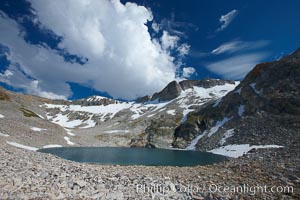
Nameless Lake (10709'), surrounded by glacier-sculpted granite peaks of the Cathedral Range, near Vogelsang High Sierra Camp.
Location: Yosemite National Park, California
Image ID: 23245
Location: Yosemite National Park, California
Image ID: 23245
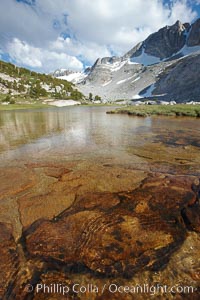
Townsley Lake, a beautiful alpine lake sitting below blue sky, clouds and Fletcher Peak (right), lies amid the Cathedral Range of glacier-sculpted granite peaks in Yosemite's high country, near Vogelsang High Sierra Camp.
Location: Yosemite National Park, California
Image ID: 23252
Location: Yosemite National Park, California
Image ID: 23252
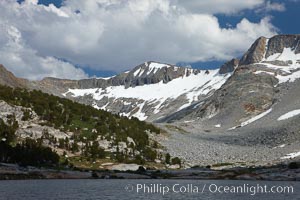
Townsley Lake, a beautiful alpine lake sitting below blue sky, clouds and Fletcher Peak (right), lies amid the Cathedral Range of glacier-sculpted granite peaks in Yosemite's high country, near Vogelsang High Sierra Camp.
Location: Yosemite National Park, California
Image ID: 23254
Location: Yosemite National Park, California
Image ID: 23254
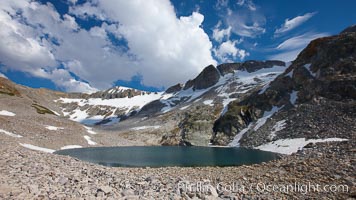
Nameless Lake, surrounded by glacier-sculpted granite peaks of the Cathedral Range, near Vogelsang High Sierra Camp.
Location: Yosemite National Park, California
Image ID: 23255
Location: Yosemite National Park, California
Image ID: 23255
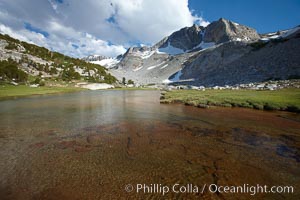
Townsley Lake, a beautiful alpine lake sitting below blue sky, clouds and Fletcher Peak (right), lies amid the Cathedral Range of glacier-sculpted granite peaks in Yosemite's high country, near Vogelsang High Sierra Camp.
Location: Yosemite National Park, California
Image ID: 23256
Location: Yosemite National Park, California
Image ID: 23256
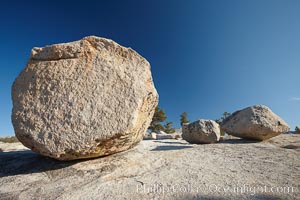
Glacial erratic boulders atop Olmsted Point. Erratics are huge boulders left behind by the passing of glaciers which carved the granite surroundings into their present-day form. When the glaciers melt, any boulders and other geologic material that it was carrying are left in place, sometimes many miles from their original location.
Location: Yosemite National Park, California
Image ID: 23265
Location: Yosemite National Park, California
Image ID: 23265
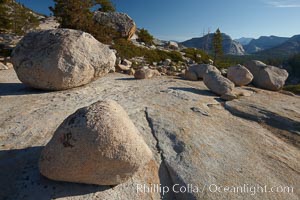
Glacial erratic boulders atop Olmsted Point. Erratics are huge boulders left behind by the passing of glaciers which carved the granite surroundings into their present-day form. When the glaciers melt, any boulders and other geologic material that it was carrying are left in place, sometimes many miles from their original location.
Location: Yosemite National Park, California
Image ID: 23279
Location: Yosemite National Park, California
Image ID: 23279
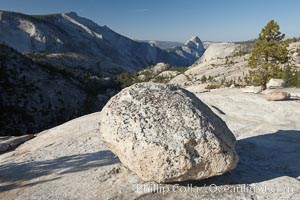
Glacial erratic boulder atop Olmsted Point, with the massive granite monoliths Half Dome and Clouds Rest in the background. Erratics are huge boulders left behind by the passing of glaciers which carved the granite surroundings into their present-day form. When the glaciers melt, any boulders and other geologic material that it was carrying are left in place, sometimes many miles from their original location.
Location: Yosemite National Park, California
Image ID: 23280
Location: Yosemite National Park, California
Image ID: 23280
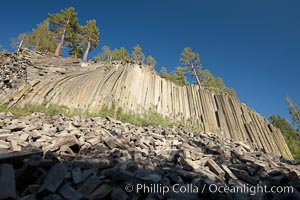
Devil's Postpile, a spectacular example of columnar basalt. Once molten and under great pressure underground, the lava that makes up Devil's Postpile cooled evenly and slowly, contracting and fracturing into polygonal-sided columns. The age of the formation is estimated between 100 and 700 thousand years old. Sometime after the basalt columns formed, a glacier passed over the formation, cutting and polishing the tops of the columns. The columns have from three to seven sides, varying because of differences in how quickly portions of the lava cooled.
Location: Devils Postpile National Monument, California
Image ID: 23281
Location: Devils Postpile National Monument, California
Image ID: 23281
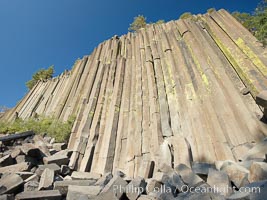
Devil's Postpile, a spectacular example of columnar basalt. Once molten and under great pressure underground, the lava that makes up Devil's Postpile cooled evenly and slowly, contracting and fracturing into polygonal-sided columns. The age of the formation is estimated between 100 and 700 thousand years old. Sometime after the basalt columns formed, a glacier passed over the formation, cutting and polishing the tops of the columns. The columns have from three to seven sides, varying because of differences in how quickly portions of the lava cooled.
Location: Devils Postpile National Monument, California
Image ID: 23282
Location: Devils Postpile National Monument, California
Image ID: 23282
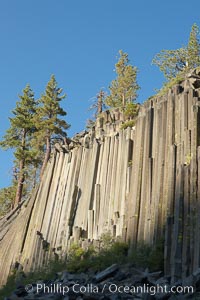
Devil's Postpile, a spectacular example of columnar basalt. Once molten and under great pressure underground, the lava that makes up Devil's Postpile cooled evenly and slowly, contracting and fracturing into polygonal-sided columns. The age of the formation is estimated between 100 and 700 thousand years old. Sometime after the basalt columns formed, a glacier passed over the formation, cutting and polishing the tops of the columns. The columns have from three to seven sides, varying because of differences in how quickly portions of the lava cooled.
Location: Devils Postpile National Monument, California
Image ID: 23283
Location: Devils Postpile National Monument, California
Image ID: 23283
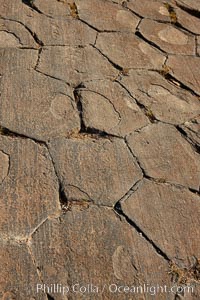
Devil's Postpile, a spectacular example of columnar basalt. Once molten and under great pressure underground, the lava that makes up Devil's Postpile cooled evenly and slowly, contracting and fracturing into polygonal-sided columns. The age of the formation is estimated between 100 and 700 thousand years old. Sometime after the basalt columns formed, a glacier passed over the formation, cutting and polishing the tops of the columns. The columns have from three to seven sides, varying because of differences in how quickly portions of the lava cooled.
Location: Devils Postpile National Monument, California
Image ID: 23284
Location: Devils Postpile National Monument, California
Image ID: 23284
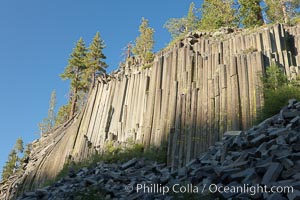
Devil's Postpile, a spectacular example of columnar basalt. Once molten and under great pressure underground, the lava that makes up Devil's Postpile cooled evenly and slowly, contracting and fracturing into polygonal-sided columns. The age of the formation is estimated between 100 and 700 thousand years old. Sometime after the basalt columns formed, a glacier passed over the formation, cutting and polishing the tops of the columns. The columns have from three to seven sides, varying because of differences in how quickly portions of the lava cooled.
Location: Devils Postpile National Monument, California
Image ID: 23286
Location: Devils Postpile National Monument, California
Image ID: 23286
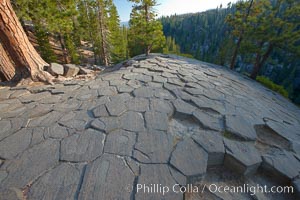
Devil's Postpile, a spectacular example of columnar basalt. Once molten and under great pressure underground, the lava that makes up Devil's Postpile cooled evenly and slowly, contracting and fracturing into polygonal-sided columns. The age of the formation is estimated between 100 and 700 thousand years old. Sometime after the basalt columns formed, a glacier passed over the formation, cutting and polishing the tops of the columns. The columns have from three to seven sides, varying because of differences in how quickly portions of the lava cooled.
Location: Devils Postpile National Monument, California
Image ID: 23287
Location: Devils Postpile National Monument, California
Image ID: 23287
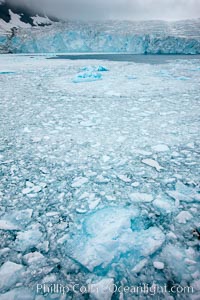
Drygalski Fjord, packed with brash ice which has broken away from Risting Glacier at the end of the narrow fjord.
Location: Drygalski Fjord, South Georgia Island
Image ID: 24687
Location: Drygalski Fjord, South Georgia Island
Image ID: 24687
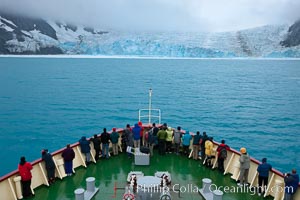
M/V Polar Star approaches Jenkins Glacier (left), Risting Glacier (center) and a third glacier (right) at the end of Drygalski Fjord.
Location: Drygalski Fjord, South Georgia Island
Image ID: 24688
Location: Drygalski Fjord, South Georgia Island
Image ID: 24688
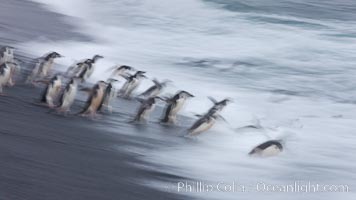
Chinstrap penguins at Bailey Head, Deception Island. Chinstrap penguins enter and exit the surf on the black sand beach at Bailey Head on Deception Island. Bailey Head is home to one of the largest colonies of chinstrap penguins in the world.
Species: Chinstrap penguin, Pygoscelis antarcticus
Location: Deception Island, Antarctic Peninsula, Antarctica
Image ID: 25456
Species: Chinstrap penguin, Pygoscelis antarcticus
Location: Deception Island, Antarctic Peninsula, Antarctica
Image ID: 25456
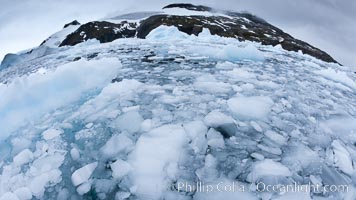
Brash ice and pack ice in Antarctica. Brash ices fills the ocean waters of Cierva Cove on the Antarctic Peninsula. The ice is a mix of sea ice that has floated near shore on the tide and chunks of ice that have fallen into the water from nearby land-bound glaciers.
Location: Cierva Cove, Antarctic Peninsula, Antarctica
Image ID: 25531
Location: Cierva Cove, Antarctic Peninsula, Antarctica
Image ID: 25531
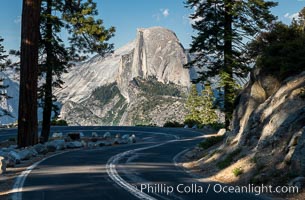
Half Dome and the Glacier Point Road, Yosemite National Park.
Location: Yosemite National Park, California
Image ID: 36379
Location: Yosemite National Park, California
Image ID: 36379
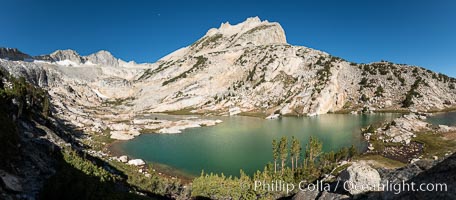
North Peak (12,242') over Conness Lake, water colored by glacier runoff, Hoover Wilderness.
Location: Conness Lakes Basin, Hoover Wilderness, California
Image ID: 36425
Panorama dimensions: 7198 x 16405
Location: Conness Lakes Basin, Hoover Wilderness, California
Image ID: 36425
Panorama dimensions: 7198 x 16405
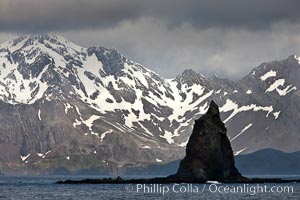
South Georgia Island coastline, showing the island's characteristic rugged topography. 56% of the island is covered by 161 glaciers, which have created numerous large bays and inlets that provide excellent habitat for marine animals and seabirds. Mountains meet the sea in steep-sided seacliffs covered with sparse vegetation. The highest point on South Georgia Island is Mt. Paget at 2,915m.
Location: South Georgia Island
Image ID: 24321
Location: South Georgia Island
Image ID: 24321
